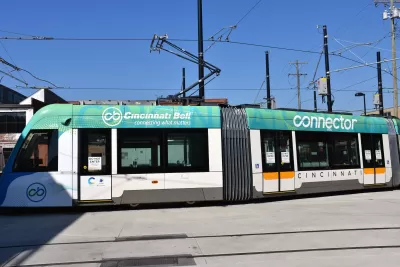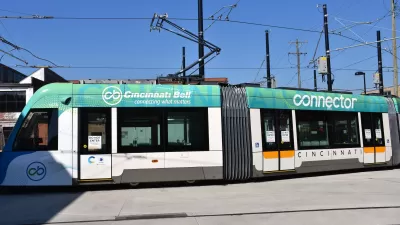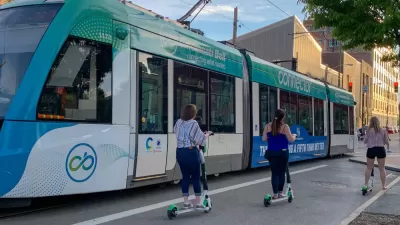A dive into the reach of the Cincinnati Bell Connector's influence on a revitalizing urban neighborhood.

The Cincinnati Business Courier, led by Chris Wetterich and Tom Demeropolis, has published an analysis of the Cincinnati Streetcar, which is actually called the Cincinnati Bell Connector.
The streetcar opened in September following years of controversy, and made the news for the wrong reasons (poor service and sluggish ridership) earlier in December. At the end of the year of the Bell Connector's opning, Wetterich and Demeropolis analyze the real estate impact of the streetcar, recognizing opposing sides to a debate about the drivers of the ongoing revival of the city's Over-the-Rhine neighborhood. Streetcar opponents credit "the city’s generous tax incentive program (which is available in every city neighborhood)" or "the Cincinnati Center City Development Corp. [bringing] urban redevelopment to a large scale." Streetcar supporters "want to attribute nearly everything good that has happened in downtown and Over-the-Rhine to the $148 million project."
Wetterich and Demeropolis inquired with building owners along the streetcar route who had pulled construction permits since 2012 (totaling $160 million in investment) to ask the question: "How much of a factor was the streetcar in your decision to build?" They didn't expect to find receive many straight answers, given the politicized nature of the project, but they were wrong. "Dozens of building owners, developers and lessees were willing to talk with us and be candid about whether the streetcar influenced their decision-making," writes Wetterich.
Unfortunately, the Business Courier's database of findings regarding the Bell Connector's investment impact remains locked by a subscriber paywall, but the free article previewing the work provides testimonials of six of the contacts the two spoke with in gathering the data for the analysis.
FULL STORY: A deeper look at the Courier’s big streetcar project

Planetizen Federal Action Tracker
A weekly monitor of how Trump’s orders and actions are impacting planners and planning in America.

San Francisco's School District Spent $105M To Build Affordable Housing for Teachers — And That's Just the Beginning
SFUSD joins a growing list of school districts using their land holdings to address housing affordability challenges faced by their own employees.

The Tiny, Adorable $7,000 Car Turning Japan Onto EVs
The single seat Mibot charges from a regular plug as quickly as an iPad, and is about half the price of an average EV.

Seattle's Plan for Adopting Driverless Cars
Equity, safety, accessibility and affordability are front of mind as the city prepares for robotaxis and other autonomous vehicles.

As Trump Phases Out FEMA, Is It Time to Flee the Floodplains?
With less federal funding available for disaster relief efforts, the need to relocate at-risk communities is more urgent than ever.

With Protected Lanes, 460% More People Commute by Bike
For those needing more ammo, more data proving what we already knew is here.
Urban Design for Planners 1: Software Tools
This six-course series explores essential urban design concepts using open source software and equips planners with the tools they need to participate fully in the urban design process.
Planning for Universal Design
Learn the tools for implementing Universal Design in planning regulations.
Smith Gee Studio
City of Charlotte
City of Camden Redevelopment Agency
City of Astoria
Transportation Research & Education Center (TREC) at Portland State University
US High Speed Rail Association
City of Camden Redevelopment Agency
Municipality of Princeton (NJ)




























